Integrated Sustainability ReportPerformance
Social
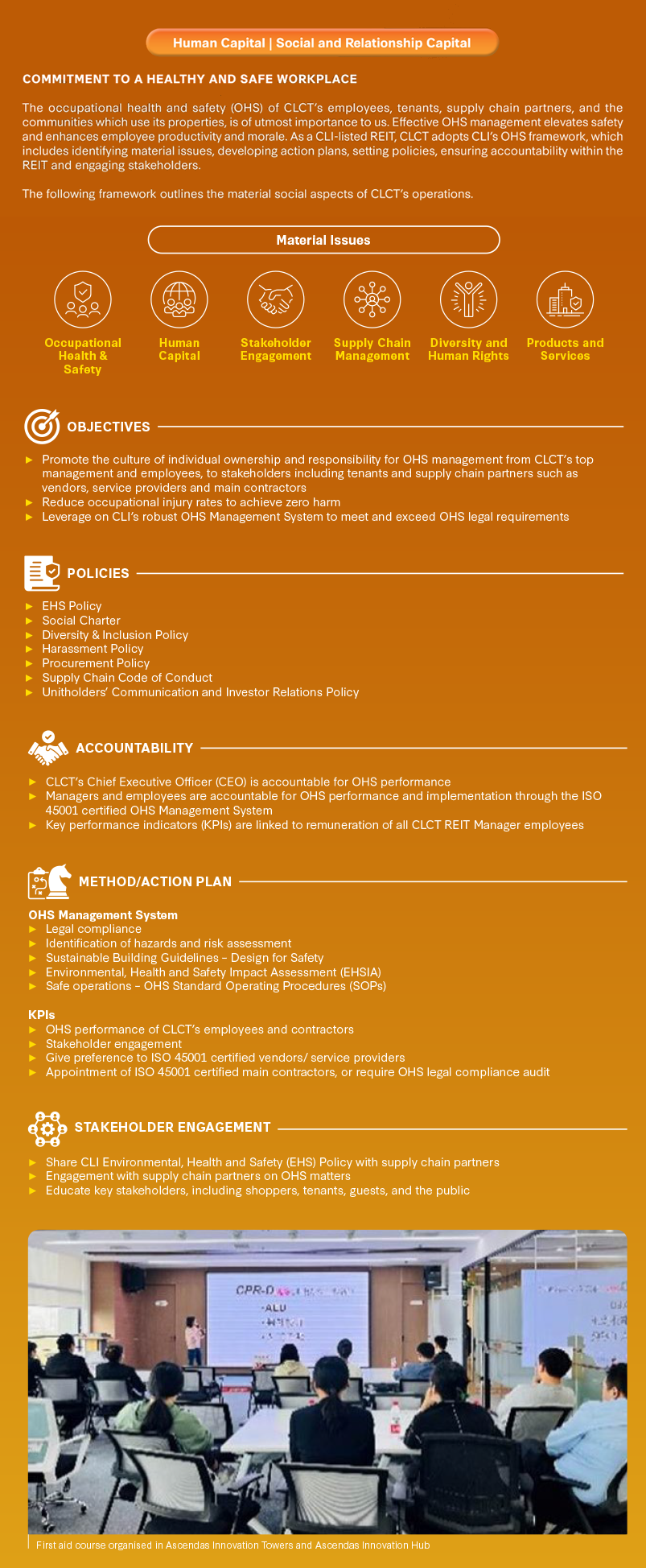
CLCT’s Social Targets
2030 SMP TARGETS AND CLCT’S PERFORMANCE
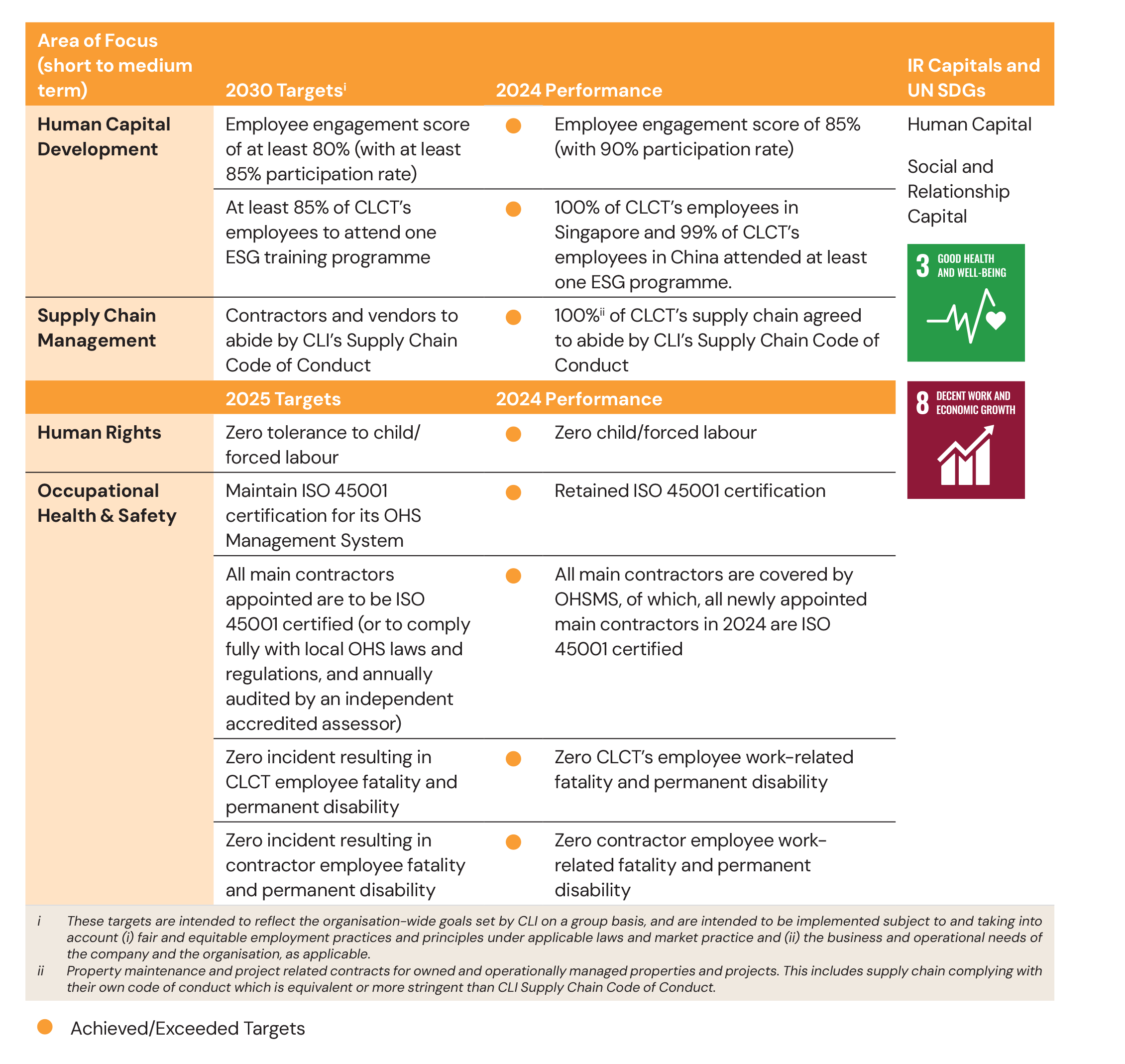
Measuring Our Safety Performance
Work-Related Injuries
CLCT’s OHS performance monitoring includes all employees (both full-time and part-time) and contractors involved in the daily operations. This year, we reported one incident of workplace injuries19 involving our employee in China. Since the incident, we have further enhanced our OHS performance through close monitoring of our OHS practices, improving our SOPs and reinforcing our safety standards. To prevent similar incidents in the future, we have shared the lessons learned and taken corrective actions in line with the hierarchy of controls, including refresher safety training and the installation of additional warning signs. The affected CLCT employee has fully recovered and returned to work.
There were zero incidents of work-related fatalities, high consequence injuries and occupational diseases involving our employees and contractors.

Top Management Commitment and Staff Involvement
CLI champions OHS with commitment from the top management and employee participation through an integrated EHS Management System as well as stakeholder engagement activities. CLCT’s CEO is accountable for the OHS performance of CLCT. Employees are required to take personal responsibility for their OHS and are encouraged to be forthcoming in reporting OHS-related incidents, including non-compliances and non-conformities.
Key Performance Indicators (KPIs) Tied to Remuneration
CLCT integrates OHS KPIs with the remuneration of all CLCT employees, including its top management.
Robust OHS Management System
CLCT’s approach to health and safety is guided by CLI’s OHSMS. As a CLI-listed REIT, CLCT adheres to CLI’s EHS Policy, which outlines its commitment to manage OHS issues. This policy is communicated regularly to employees through meetings or other communication channels. Further details on CLI’s EHS Policy can be found on page 16 of this Report, or at https://www.capitaland.com/en/investment/sustainability/esg-policies.html.
Certified to International Standards
CLI’s OHSMS has been externally audited to recognise international standards for OHS Management Systems since 2009 by third-party accredited certification bodies. CLI has obtained ISO 45001 OHSMS certification in 19 countries, including China, where CLCT operates. This encompasses all business functions including property management and operations, project development and corporate office management.
Internal and External ISO Audits
CLCT leverages CLI’s internal audit system to assure EHS conformance and effective implementation that is aligned to the ISO 14001 and ISO 45001 standards. Both internal and external audits are conducted annually with an accredited third-party certification body to provide stakeholders with assurance of our EHS legal compliance and commitment to best practices.
Compliance
Legal requirements are reviewed on a quarterly basis, and adherence to these requirements are evaluated annually.
Risk Management of OHS Hazards
We follow CLI’s OHSMS to identify and assess workplace health and safety risks, using the results from the risk assessment to develop control measures, such as house rules, guidelines, and OHS programs. A cross-functional team of members from various work areas conduct Hazard Identification and Risk Assessment (HIRA), recognising hazards in job activities and evaluating potential accidents or incidents.
The primary objective during this phase is to identify hazards and brainstorm all possible types of accidents or health issues that may arise. CLCT provides the cross-functional team with a systematic approach to implement HIRA by:
- Identifying hazards;
- Evaluating the risks;
- Determining the level of risks; and
- Preparing action plan to eliminate, contain or control the risks.
In the event of a workplace health and safety incident, including work-related injuries or illnesses that result in death, lost workdays, medical treatment, or first-aid treatment, as well as any near-miss incidents, employees are required to notify the immediate supervisory within 24 hours.
Upon receiving the report, the Supervisor will begin investigating the root cause, conduct a risk assessment, and implement corrective actions. The assessment evaluates risks by severity and likelihood, while control measures consider legal requirements and codes of practice. Corrective actions are determined using the risk control hierarchy, with priorities and initiatives outlined in the table below.
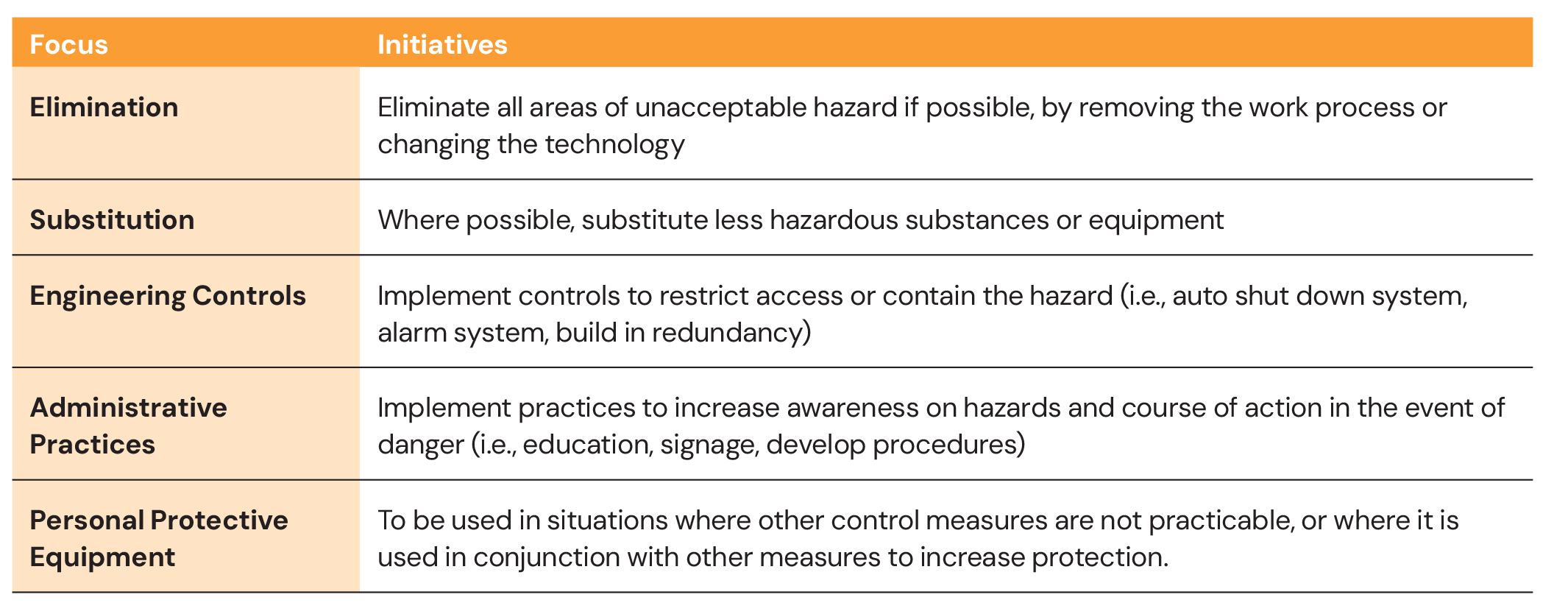
Once the corrective actions have been implemented, the Supervisor is required to submit an Incident Investigation Report to the respective Strategic Business Unit (SBU) Human Resource and SBU EHS Management Representative (EHSMR) within 7 calendar days of the incident. The EHSMRs will track and document the corrective actions implemented and any observed trends in incident occurrence within the HIRA register accordingly. The HIRA is reviewed annually, or following an incident, or a significant change in processes.
The ESIA is a mandatory requirement when evaluating new investments, ensuring our compliance with ISO 45001 and enabling the identification of OHS risks and opportunities early. This allows for the implementation of effective mitigating measures across all projects.
Aligning with CLI’s guidance on safety, CLCT adheres to the Global Safety Guidelines newly introduced by CLI to further strengthen safety processes and practices across all properties globally.

To enhance our OHS performance, we will continue to review and improve the suitability, adequacy, and effectiveness of the OHSMS.
Training and Awareness – OHSMS
To facilitate the effective implementation of CLI’s OHSMS, training and awareness programmes are organised as part of the integrated training for employees. The OHS of employees were improved through the study of various safety and health courses.
Training sessions are also conducted for CLCT’s contractors and suppliers, as part of our efforts to foster a more environmentally conscious and safe culture for our stakeholders. In 2024, 100% contractors and suppliers attended in-house safety training, covering EHS-related topics.
Operational management process ensures contractors comply with strict safety regulations, including mandatory safety briefings and the use of personal protective equipment, such as boots, helmets, and gloves. CLCT enforces these regulations through regular inspections to safeguard stakeholders’ health and safety.
Reinforcing OHS Culture through Digitalisation
In China, CLI continued to deploy its digital solution for EHS-related inspections that records observations and EHS scores. The solution was deployed across more than 55 CLI operationally managed properties in China. In 2024, over 36 EHS-related inspections were conducted at CLCT properties.
Employee Engagement
CLCT fosters employee engagement through different channels including regular communication sessions with senior management to ensure effective information flow and alignment of business goals across all levels of the workforce. CLCTML’s CEO also holds regular interactive sessions with the team to facilitate two-way communication. At CLI Group level, various events were organised to provide opportunities for employee engagement and interaction across business units.
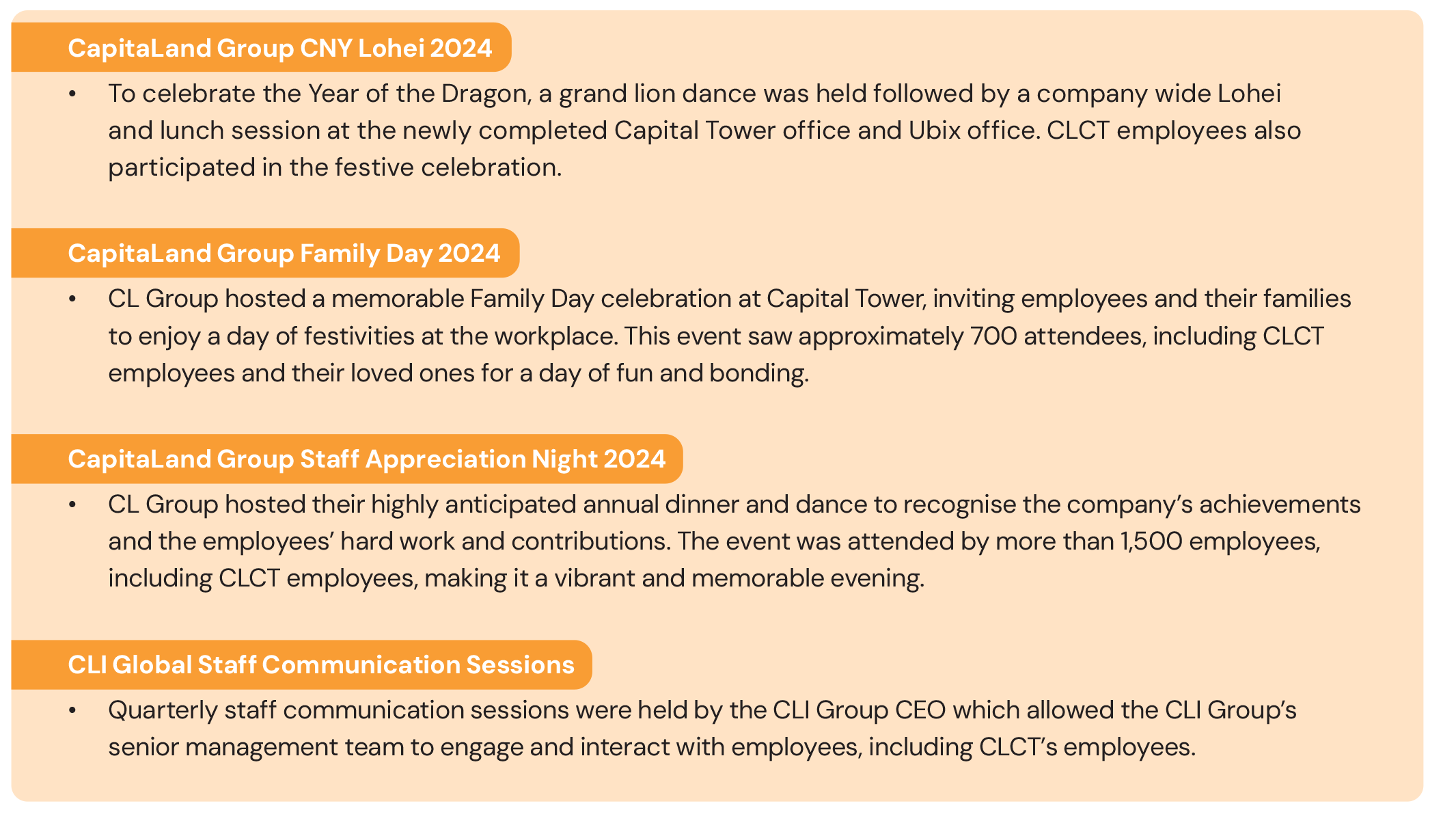
CLI Employee Engagement Survey 2024
In 2024, CLI launched a Global Employee Engagement Survey (EES) from 16 October to 3 November, conducted by an independent third-party vendor. The purpose was to assess employee engagement and well-being as well as the perception of work culture. The survey consisted of 27 scale questions, 2 drop-down questions and 2 open-ended questions. The scale questions are aligned to 8 key themes relating to employee experience, which are Core Values, Growth & Development, Empowerment & Accountability, Performance & Recognition, Work Process, Collaboration & Teamwork/Immediate Manager, Employee Wellbeing and Culture. Open-ended questions allowed employees to share feedback on organisational culture and areas for improvement as well as provide suggestions. This survey achieved a participation rate of 90% and engagement score of 85%, including participation from CLCT employees.
Stakeholder Engagement
CLCT’s social and relationship capital is fundamental to our ability to strengthen our social license to operate and generate sustainable value for our stakeholders over the long term. We recognise that our key stakeholders—employees, investors, analysts, media, tenants, shoppers, suppliers, government agencies, regulators, and local communities— are directly impacted by our operations and have a vested interest in our business.
We are committed to understanding their perspectives and maintaining open, effective communication. Through diverse engagement methods, we address their concerns and ensure their voices are heard.
Engagement with Employees
CLCT actively engages our employees through various avenues. Please refer to the Human Capital chapter on page 33 of this Report for more details on the employee engagement survey and programmes conducted in 2024. Additionally, CLCT also advocates for employee volunteerism as an integral part of building a caring and inclusive community.

Engagement with Investors, Analysts and Media
Guided by our Investor Relations (IR) policy27, CLCT builds investor confidence through strong corporate transparency and effective two-way communication. We strive to furnish accurate and timely information to foster trust and confidence through consistent and clear communication with our stakeholders, allowing them to make well-informed investment decisions.
All material information, including financial results, business updates, annual reports and presentation decks used at conferences and roadshows, is promptly disclosed on SGXNet and CLCT’s corporate website. Investors can subscribe to email alerts for timely updates on CLCT’s announcements and press releases.
We also organise events and participate in conferences, offering opportunities for the investment community and media to engage with senior management and learn more about the REIT’s operations. Investors and the general public can also reach out to us through a dedicated “Ask Us” email address (ask-us@clct.com.sg). For more details on CLCT’s investor and media relations efforts, please refer to Investor Relations section on pages 34 to 35 of the CLCT’s AR 2024.
Engagement with Customers (Tenants and Shoppers)
In line with CapitaLand’s sustainability strategy, tenant and shopper engagement remains a key focus at CLCT. CLCT actively organises community-building initiatives to enhance tenant stickiness. Numerous events were conducted in 2024 to foster greater interaction and build a thriving community.
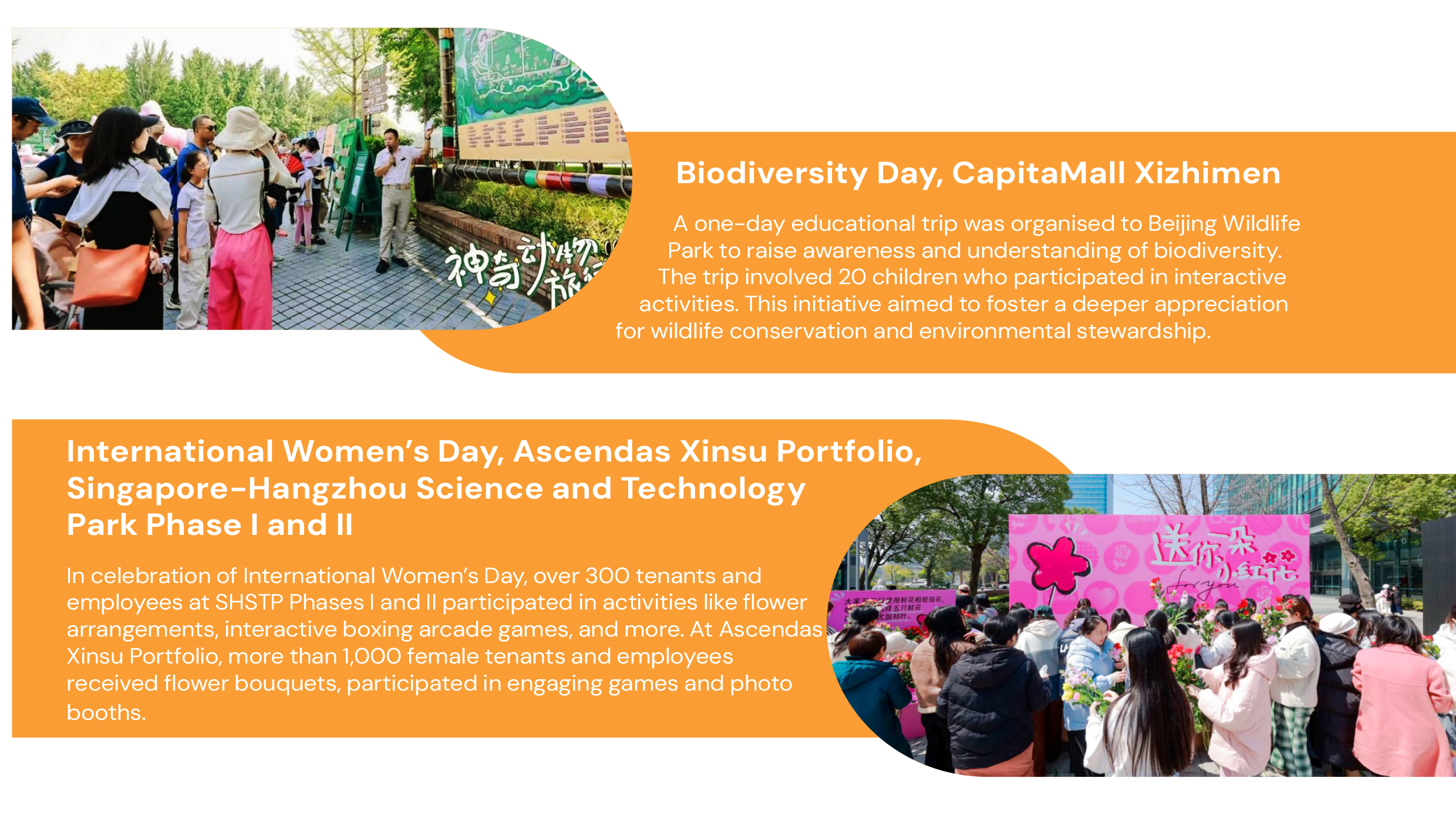
CLCT regularly conducts tenant satisfaction surveys at its shopping malls and business parks. The feedback gathered is reviewed, and appropriate follow-up actions are taken to enhance the experience and service levels for both tenants and shoppers. These surveys provide us with specific, actionable insights, enabling us to better address our tenants’ and shoppers’ needs and concerns.
In 2024, tenant satisfaction surveys were conducted at all 17 CLCT properties excluding Shanghai Fengxian Logistics Park, with an overall participation rate of 75.4%. CLCT garnered feedback on a range of matters from cleanliness, security, mall ambience to the adequacy of car park lots. The results from our tenant satisfaction survey show that 96.9% of tenants are satisfied with the services provided.
Supply Chain Management
As a CLI-listed REIT, CLCT adopts the sustainable procurement principles in the CLI Procurement Policy. This is in alignment with CLI’s sustainability commitments as a signatory to the UNGC. Its supply chain providers (suppliers) are assessed for their ability to adhere to CLI’s sustainability practices during the admission and pre-qualification stages. The appointed suppliers are subject to regular evaluations of their performance to ensure ongoing adherence to the procurement policy. Non-compliances will be flagged out for correction and high sustainability risk suppliers with performance issues will be monitored closely for improvement. Suppliers that contravened or attempted to contravene any Anti-Corruption Laws will be subject to termination of the contract.
In enhancing CLI’s supply chain management on ESG performance, a pilot screening of nearly 500 critical suppliers in Singapore, China, and India was initiated. The screening, using an Artificial Intelligence-powered ESG due diligence platform, assessed suppliers’ risk and resilience across ESG pillars, including corruption, human rights, safety, and environmental compliance. ESG specialists reviewed flagged issues, and CLI worked with the platform provider to implement capability-building programs for suppliers with below-average scores. These programs included gap analysis, interviews, and tailored action plans to improve supplier awareness and ESG performance.
Government Agencies and Regulators
CLCT is committed to regulatory compliance. Procedures are in place to ensure that its activities and operations comply with existing regulatory requirements. This commitment is upheld through consistent monitoring, evaluation, and audit of the CLI EHS management system.
Community/NGOs
CLCT organises activities focused on community investment, raising awareness, and stakeholder engagement in philanthropy, environment, and health and safety. In China, the public and tenants can sign up for these events at CLCT’s retail malls and business parks, generating social capital that supports business growth. In 2024, a total of 1,140 volunteer service hours were contributed both in Singapore and China.
Our Sponsor, CLI, invests in local communities by identifying causes with stakeholders and involving employees. Through our philanthropic arm, CapitaLand Hope Foundation (CHF), we contribute towards building resilience, supporting education, health, and well-being initiatives, targeting children, youth, and seniors in communities where CapitaLand operates.
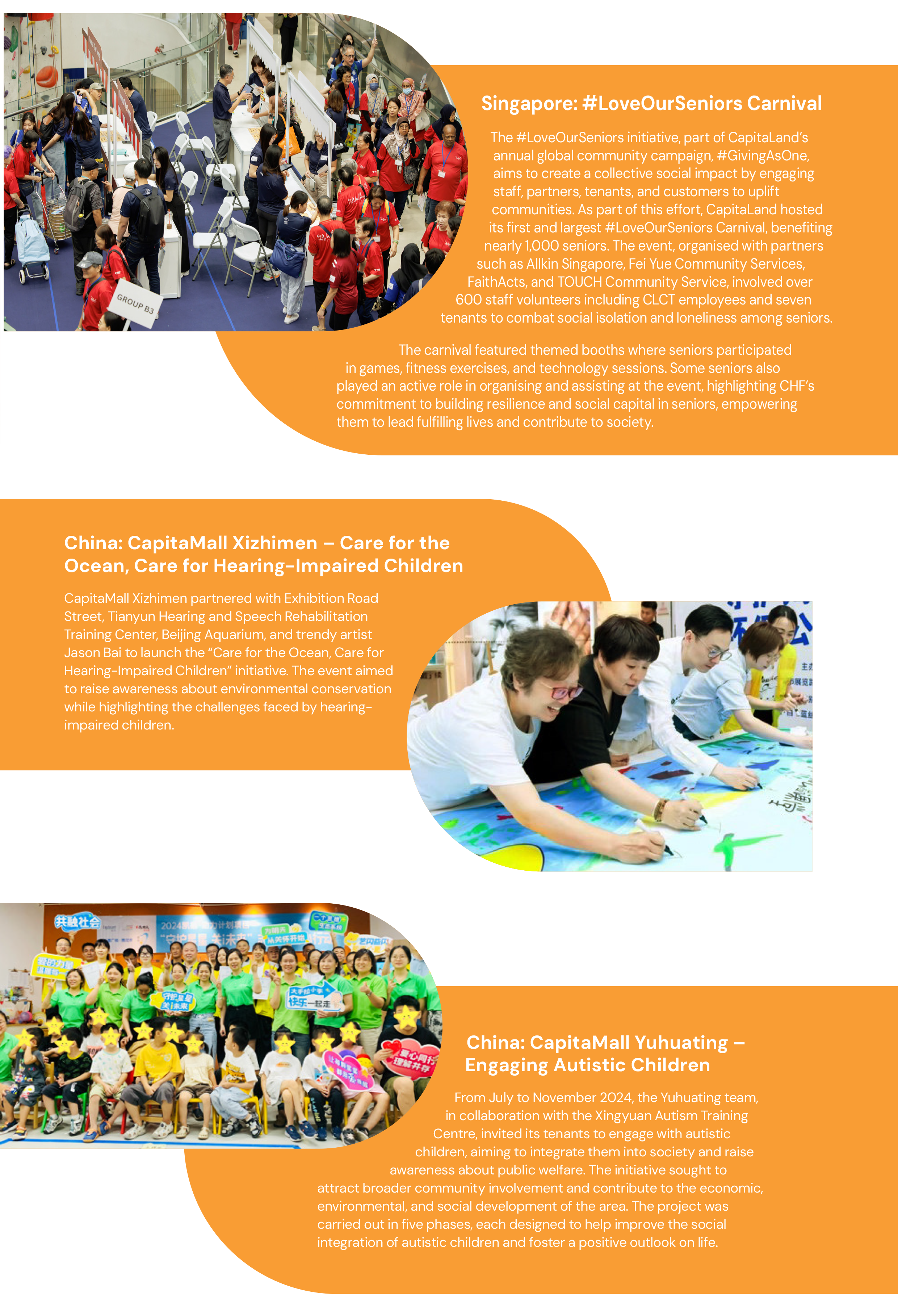

 Environmental
Environmental
 Governance
Governance